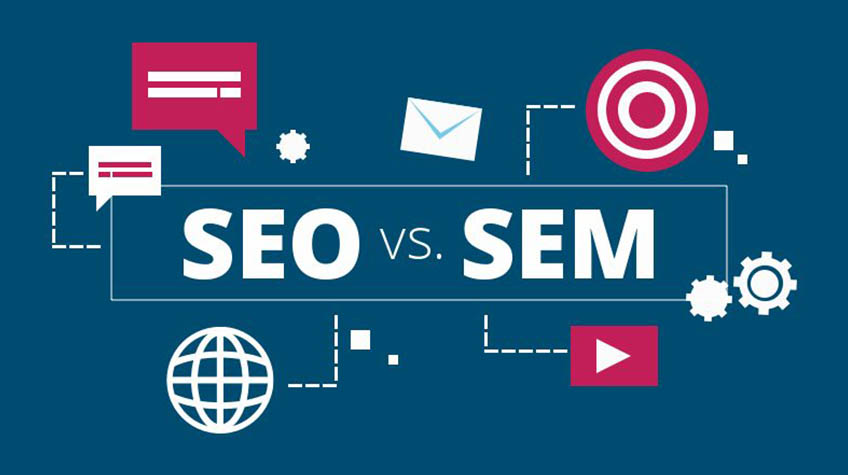
SEO (search engine optimization) and SEM (search engine marketing) are two terms that are often mistaken for each other. Marketing professionals understand these terms intimately and know how valuable they are to reaching target audiences. Often, SEO and SEM are used together. While they share the same goal among other similarities, there are key differences between SEO and SEM.
► What Is SEO?
SEO is one of the most commonly used terms in marketing. It refers to the process of augmenting websites to increase traffic organically driven by search engines. Search engines evaluate websites using keywords and titles and then rank them according to an algorithm of numerous ranking signals. By optimizing the website, its visibility on SERPs (search engine results pages) improves.
Around 60% of marketers deliberately invest their time in SEO because of its copious benefits. A study found that SEO attracts 1000% more organic traffic than social media. In addition to boosting brand awareness, SEO has the power to improve your credibility as a business. The amount of time marketers invest in creating high-quality content and researching keywords will have tremendous returns. Effective and consistent SEO enables businesses to magnify their target audience and maximize their revenue. The best part about SEO is that it costs nothing but time.
To increase their ranking on organic search results, businesses should focus on producing quality content. Identifying the best keywords and authoritative links to incorporate in the writing is another way to impress the search engine algorithm.
► What is SEM or PPC?
SEM refers to paid search advertising methods or PPC (pay-per-click). Businesses that are looking for instant results benefit greatly from PPC. It immediately drives a lot of traffic to your website. An example of SEM is the ad results at the top of your Google search results. Each time someone clicks on the ad, the business pays the search engine.
Businesses must place a PPC bid in an auction in order to secure a spot at the top of search results. These bids are on keywords so the website appears in relevant searches and reaches its target audience. Although it costs money, winning a bid for a top ad placement is highly effective at converting traffic into sales. A 2019 study by Think With Google found that 49% of users use Google to find a new product.
Many wrongly assume that PPC is expensive. Businesses can actually choose to bid on the most effective keywords with a low price. Thus, keyword research is key to getting the best return out of PPCs as a business.
The Comparison Between SEO And SEM
SEO aims to improve ranking in the organic search results. Meanwhile, SEM’s goal is to rank highly in both organic results and paid search results.
SEO takes longer to produce results. It could take months or years for a new website actively investing time into their SEO to rank highly on SERPs. When marketers spend their time on SEO, they know they’re in it for the long run. It requires a lot of patience, but the payoff is worth it. SEM, on the other hand, produces instant results. Winning a bid to a good keyword and crafting an effective PPC ad could boost traffic to your site almost instantaneously.
SEO costs businesses no money. Instead, the cost is time. While SEO is free, SEM is not. Businesses pay every time their ad is clicked and traffic is directed to the site. Fortunately, the cost per click for a lot of good keywords are not expensive.
SEO relies on data on their target consumers to create an optimized website and improve their ranking organically, while SEM depends on bounce rate and click-through rate.
► Why Businesses Should Use Both
SEO and SEM both appear in the same search results. They share the same goals. They both strive to improve the site’s visibility on SERPs and boost traffic that will hopefully convert into sales. Their effectiveness are both determined by how well the keywords are researched. Those keywords determine the website’s ability to reach and expand its target consumers. As a result, marketers frequently use SEM to determine the effectiveness of keywords before they implement them into their SEO strategy.
Since the success of SEO and SEM both rely on optimization, SEM websites must also be SEO-friendly in order to generate results.
In the same way that marketers use SEM to improve their SEO strategy, they also use SEO to ensure their PPC ads succeed. Businesses should consider using both in their marketing strategy.
► When To Use SEO Without SEM
Businesses that aren’t in a rush to see a large amount of traffic on their website can just use a SEO strategy and succeed. It might require more time than SEM, but the results of an effective SEO strategy is long-lasting. Once you put in the time to create a highly optimized website with quality content, great keywords, and authoritative links, you can expect to consistently rank at the top of search engine results pages.
► When To Use SEM Without SEO
Businesses that need results quickly and have the budget to pay for PPC ads might just use SEM at first. However, since the success of PPC ads is influenced by how SEO-friendly the website is, businesses should consider using an SEO strategy as soon as they can.
Conclusion
SEO and SEM differ in various ways. While SEO focuses on increasing organic traffic, SEM employs well-crafted ads to boost paid traffic to the website. SEO is free, while SEM costs money. SEO is time-consuming, but SEM generates instant results. However, they also complement each other. They share several similarities including their objectives. Businesses can benefit greatly from both strategies. Instead of choosing one or the other, allow your SEO strategy to improve your SEM strategy and vice versa.
Jenny Williams is a business analyst and writer at Edinburgh writing service who writes about marketing strategies.






